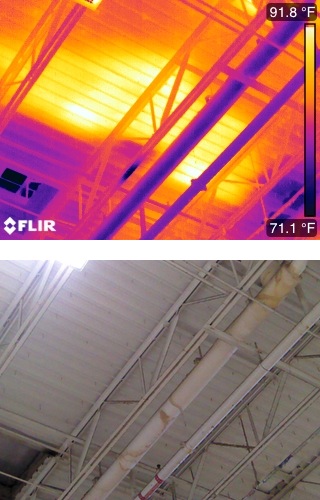Recently a 20 year veteran of the commercial roofing industry dropped by the Ivy Tools office to share some of his successes using the FLIR T420 Thermal Camera for roof inspections. Dennis Olsen had come to us a few months prior, looking to add thermal imaging to his roofing business. He had occasionally used thermal cameras for roof inspections, and now that prices had come down significantly, Olsen wanted to have one on hand all the time. The thermal camera gives his company the ability to troubleshoot complicated roof leaks and locate points of failure quickly.

Water running between the insulation and ponding on a metal roof deck, as seen from the roof. Detected at night with a FLIR T420 Thermal Camera.
Oversimplifying a bit, flat commercial roofs are usually built by laying a metal roof deck over a system of roof trusses. Then a layer of insulation such as thick foam or lightweight concrete is added overtop the metal deck. Finally, a waterproof membrane is placed over the insulation in order to shed water toward the roof drains. As the membrane wears over time, or fails along seams due to age or installation error, water finds its way into the insulation layer. Running along seams of the insulation, the water will eventually reach the roof deck and leak into the interior of the building around the joints or perforations of the metal.
Thermal cameras are an excellent tool for locating roof leaks and detecting water that is ponding on a roof deck. Because water exchanges heat at a different rate than the dry roofing materials, the thermal camera can detect the different heat patterns, giving indication of where water intrusion or ponding is likely. At times, however, the water in the roof will be at the same temperature as the roof itself. And of course, the sun can play a large role in masking subtle temperature patterns on a roof. Consequently, roof inspections are best done when the building is changing temperature and out of the sun. This usually translates to a nighttime inspection for commercial roofs.

Water ponding on a commercial roof deck, seen from the inside. Olsen solved the leak by resealing the edges of the cap sheet membrane.
Olsen receives many calls from big-box retailers, manufacturing facilities, and warehouse operators complaining of persistent roof leaks. Sometimes these leaks are even on new roofs and the original contractor just can’t solve the problem. These troubleshooting calls can be the blessing and the curse of the commercial roofer. Because of the many layers of a flat roof system, the point where water actually drips into the building can be far from the point where it enters the roofing system. This is where Olsen reports that the FLIR T420 has given him the edge. Under the right conditions, he can use the thermal camera to actually see the path the water has taken, from the membrane, through the roof, to the inside of the building. When facility managers are almost willing to throw in the towel and pay tens of thousands of dollars or more for a new roof, Olsen can often solve their problem by locating the point of entry and repairing the membrane. They are very grateful, as you can imagine.
Thanks to Dennis Olsen of Olsen Roofing for providing photos and letting us share his story. He’s using a FLIR T420 Thermal Camera to expand his business and save his clients money. Questions or comments? Please let us know in the comments section below, or give us a call at (877) 273-2311.